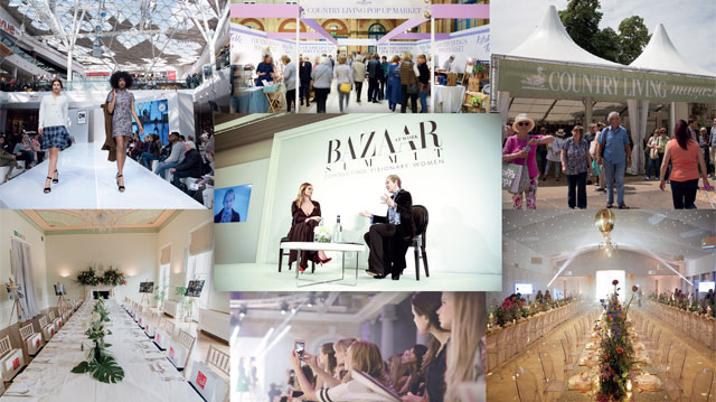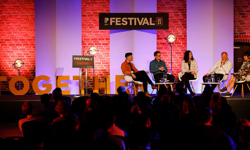
Victoria Archbold, managing director of events and sponsorship at Hearst UK, has been at the forefront of this shift from “looking in to joining in”, which has seen events move from the periphery to centre stage when it comes to driving consumer loyalty and revenues.
We meet at Hearst’s swanky new headquarters just off London’s Leicester Square – her team has just moved in and they are still getting used to the space age interiors, where your swipe card tells you which lift to take.
Archbold oversees Hearst Live, the publisher’s events division, which creates sell-out events for brands including Cosmopolitan, Elle, Esquire, Harper’s Bazaar, Good Housekeeping, Red and Country Living. She was with Hearst for ten years before moving to her current role in January, and has been very much part of the thinking behind the creation of Hearst Live as an internal events agency.
She explains that rather than the old approach of ‘Look at us at this event, wasn’t it wonderful’, when the reader was invited to peek in at the rich and famous, now they are invited to the party. Even if they cannot attend in person, the editorial teams capture content to create post-event features – both in print and on digital platforms – which answer questions relevant to the consumer. For example, Cosmo readers might want tips on how they can become the next big influencer.
She adds: “I wanted Hearst to be at the forefront of thinking about how we run events as part of our whole strategy, not just an add-on to other campaigns that we were doing, but a core calendar of events that were recognised both by our advertisers and also by our consumers.”
This calendar of events, which is now planned far in advance, includes the Cosmopolitan Self Made Summit – where millennials can learn about setting up their own business or becoming an influencer; Red Smart Women Week, which offers careers masterclasses alongside fitness and beauty workshops and, this year, the Elle Weekender, a new interactive three-day event encompassing fashion, beauty and wellness. Archbold explains that once they are established in the calendar, these events become “a framework to operate within as you would evolve content within a magazine or website”.
Content-led
Hearst’s approach to events is “content first”. In the case of Harper’s Bazaar, they looked at the magazine and asked what it is famous for – high-flying women, art and literature – so each month, they run a ‘Bazaar at Work’ session, culminating in an annual summit in November, where they bring together women at CEO or director level from across the UK and discuss subjects that are important to them in both their careers and personal lives. Bazaar has also just hosted its first literary salon and there are plans afoot to stage an art event later this year.
“We very much function around purpose and passion,” Archbold says. “A purpose would be the business. For a Cosmo millennial reader, it would be Self Made where she would come and she would hear about what career does she want to go into, how does she start up a business, how does she become the next big influencer. On the passion side, in the case of a Woman’s Health consumer, that would be wellness, or fitness, or mindfulness.”
The company recognises that today’s audiences cross over between different brands, allowing them to help advertisers reach consumers by interest groups rather than narrow age brackets. “We live less by demographics now and more by an idealism of how we like to spend our lives. It’s very much a mindset,” she insists.
There is also some crossover between brand events: “I need to make sure that my brands are not competing against one another unnecessarily, but there is that beautiful Venn diagram overlap where people can come to a Bazaar event and a Red event. Or I might be a mother who has come to a Good Housekeeping event, but my daughter’s come to a Cosmopolitan event.”
She does not shy away from admitting that Hearst Live wants to make money from events. “Often people creep around the idea of making money from events. We don’t. Our drive is two things: fame and fortune. Our brands are famous and I’m aiming to make our events pillars within those brands. People put dates in their diaries and they come. In that respect, there is a fortune side if you want to talk money. Hearst hasn't made a secret that we are diversifying revenues.”
As a private company, Hearst does not go into detail on finances, but ticket prices range between £15 and £500 depending on the event and in 2017, the number of event attendees doubled. “That good quality consumer coming to that trusted, well-respected event means in turn that I can drive that revenue in sponsorship from advertising brands,” says Archbold.
Extended life cycle
Events have now become content generating machines in their own right, whether it be videos of the speakers and panel sessions, or more bespoke material such as backstage interviews, which can then be “seeded” online, not just on Hearst’s own channels, but also on the client’s channels.
“Once the event actually happens, what you can do is capture that content in a number of different ways and push that content out after the event so that you make the lifecycle of that campaign a lot longer. Just because the event happened in London and was attended by 300 people, it doesn’t mean that you can’t amplify it beyond,” says Archbold. For example, last year’s Cosmopolitan Self Made Summit enjoyed an amplification of nine million views across digital. “They watch it on social media, they see third parties posting about it, and then we create more evergreen content such as live videos that exist on our digital platforms for the whole year after.”
Hearst Live’s relationship with advertisers and brand sponsors is a dynamic one. “I don’t go out with standard packages,” says Archbold. “I ask the advertiser not just about cash but about collaboration. The question would be, ‘what are you bringing to this event and how can we work together to do the best possible thing for the consumer?’ It’s very much about like-minded individuals and brands working together to create a consumer first approach.”
Events provide “emotional marketing”, says Archbold. “Some advertising might interrupt you whereas events and the content we create from the events is very much about involvement. Whether it’s involvement on the level you’ve bought a ticket and you come along, or whether it’s involvement that you’ve sat down and you’ve turned on your computer or your phone and you’re clicking on that link or following that social post or watching that live, there’s an active engagement.”
She believes Hearst is tapping into the market trend towards spending money on experiences rather than products. “The market trends are dictating that people are more willing to spend money on experiences than products right at this moment. People look to us to support the purpose and the passions in their life. There’s been a shift in what the consumer demands and therefore there has been a shift in the brands and the way that we communicate with our consumers.”
Team building
Archbold has built her team by gathering together as many different experts as she can. “It’s very much about recruiting those experts into the business and not relying on people within the business who do other roles. Other publishers might expect the PR department or somebody’s PA to deliver an event because they might be able to deliver a very good meeting or gathering of internal people. That isn’t the same skill as being able to deliver an event of that calibre on that scale to consumers.” She has a team of around 40 people working on a matrix model with four verticals: lifestyle, luxury, young women’s and wellness, and four horizontals: events, campaign management, sponsorship delivery and sponsorship sales.
When it comes to event venues, it is important to find the right match. Archbold explains: “We have a partnership with [the upmarket restaurant firm] Caprice Holdings for Bazaar at Work; our audience is their audience, so they asked whether they could host our events in their venues.” Meanwhile, this year’s Cosmopolitan Self Made Summit was held in the new venue at Westminster’s County Hall run by Etc. Venues, while Bazaar also uses Sotheby’s Auction House, demonstrating the importance of art to its brand.
So, what’s next for events at Hearst? Archbold is currently working on the strategy for the next three years: “My original strategy was to enhance, exploit and extend and that has very much become normal business practice now, so it’s not a strategy any more, it’s everyday life.”
“We never sit still, we want to be leading the trends, not following them, but setting them in terms of what we’re doing not just for our advertisers, but for our consumers as well. We will continue to diversify and we will continue to look at the successes we have in our current portfolio and develop that out.”
Whatever the future holds, Hearst’s events are unlikely ever again to be relegated to the back pages of a magazine.










